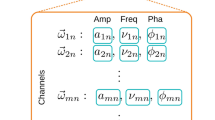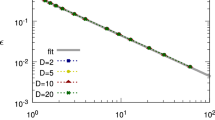Abstract
Numerical and experimental realizations of quantum control are closely connected to the properties of the mapping from the control to the unitary propagator (Rabitz et al. in Science 303(5666):1998–2001, 2004). For bilinear quantum control problems, no general results are available to fully determine when this mapping is singular or not. In this paper we give sufficient conditions, in terms of elements of the evolution semigroup, for a trajectory to be non-singular. We identify two lists of “way-points” that, when reached, ensure the non-singularity of the control trajectory. It is found that under appropriate hypotheses one of those lists does not depend on the values of the coupling operator matrix.
Similar content being viewed by others
References
Albertini, F., D’Alessandro, D.: Notions of controllability for multilevel bilinear quantum mechanical systems. IEEE Trans. Autom. Control 48(8), 1399–1403 (2003)
Altafini, C.: Controllability of quantum mechanical systems by root space decomposition of su(N). J. Math. Phys. 43(5), 2051–2062 (2002)
Assion, A., Baumert, T., Bergt, M., Brixner, T., Kiefer, B., Seyfried, V., Strehle, M., Gerber, G.: Control of chemical reactions by feedback-optimized phase-shaped femtosecond laser pulses. Science 282, 919–922 (1998)
Bardeen, C., Yakovlev, V.V., Wilson, K.R., Carpenter, S.D., Weber, P.M., Warren, W.S.: Feedback quantum control of molecular electronic population transfer. Chem. Phys. Lett. 280, 151–158 (1997)
Bardeen, C.J., Yakovlev, V.V., Squier, J.A., Wilson, K.R.: Quantum control of population transfer in green flourescent protein by using chirped femtosecond pulses. J. Am. Chem. Soc. 120, 13,023–13,027 (1998)
D’Alessandro, D.: Introduction to Quantum Control and Dynamics. Chapman & Hall/CRC Applied Mathematics and Nonlinear Science Series. Chapman & Hall/CRC, Boca Raton (2008)
Girardeau, M.D., Schirmer, S.G., Leahy, J.V., Koch, R.M.: Kinematical bounds on optimization of observables for quantum systems. Phys. Rev. A 58(4), 2684–2689 (1998). doi:10.1103/PhysRevA.58.2684
Ho, T.S., Rabitz, H.: Why do effective quantum controls appear easy to find? J. Photochem. Photobiol. A, Chem. 180(3), 226–240 (2006). http://www.sciencedirect.com/science/article/B6TGY-4JRT33W-7/2/e487a7c6bfb086abc26371fbbe2d3e6c
Ho, T.S., Dominy, J., Rabitz, H.: Landscape of unitary transformations in controlled quantum dynamics. Phys. Rev. A 79(1), 013,422 (2009). doi:10.1103/PhysRevA.79.013422
Hornung, T., Meier, R., Motzkus, M.: Optimal control of molecular states in a learning loop with a parameterization in frequency and time domain. Chem. Phys. Lett. 326, 445–453 (2000)
Judson, R., Rabitz, H.: Teaching lasers to control molecules. Phys. Rev. Lett. 68, 1500 (1992)
Kunde, J., Baumann, B., Arlt, S., Morier-Genoud, F., Siegner, U., Keller, U.: Adaptive feedback control of ultrafast semiconductor nonlinearities. Appl. Phys. Lett. 77, 924 (2000)
Levis, R.J., Menkir, G., Rabitz, H.: Selective bond dissociation and rearrangement with optimally tailored, strong-field laser pulses. Science 292, 709–713 (2001)
Rabitz, H.A., Hsieh, M.M., Rosenthal, C.M.: Quantum optimally controlled transition landscapes. Science 303(5666), 1998–2001 (2004). doi:10.1126/science.1093649. http://www.sciencemag.org/cgi/content/abstract/303/5666/1998
Turinici, G., Rabitz, H.: Wavefunction controllability in quantum systems. J. Phys. A 36, 2565–2576 (2003)
Weinacht, T., Ahn, J., Bucksbaum, P.: Controlling the shape of a quantum wavefunction. Nature 397, 233–235 (1999)
Wu, R., Dominy, J., Ho, T.S., Rabitz, H.: Singularities of quantum control landscapes. arXiv:0907.2354 [quant-ph] (2009). http://arxiv.org/abs/0907.2354
Acknowledgements
GT acknowledges support from the ANR-06-BLAN-0052 program and the MicMac project of INRIA Rocquencourt. TSH and HR were supported by U.S. Department of Energy.
Author information
Authors and Affiliations
Corresponding author
Rights and permissions
About this article
Cite this article
Ho, TS., Rabitz, H. & Turinici, G. Critical Points of the Optimal Quantum Control Landscape: A Propagator Approach. Acta Appl Math 118, 49–56 (2012). https://doi.org/10.1007/s10440-012-9677-3
Received:
Accepted:
Published:
Issue Date:
DOI: https://doi.org/10.1007/s10440-012-9677-3




